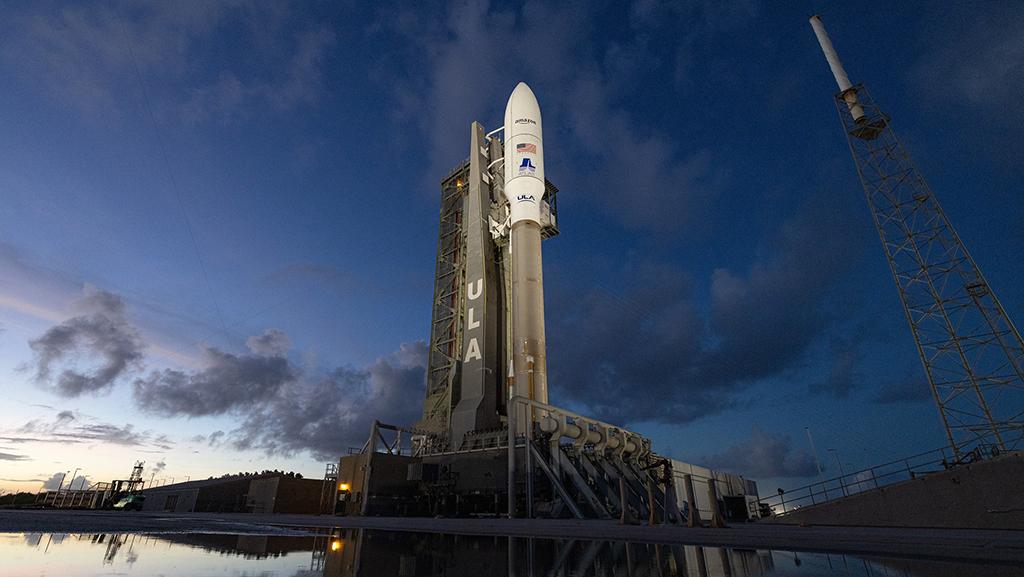
ULA makes a delivery for Amazon, sending a pair of prototype broadband satellites into orbit on Oct. 6.
Using a heavy-lift Atlas V to launch a pair of mini-fridge-size satellites into orbit may set a record for the most expensive ride to space. But Amazon, which bought the launch, considers it key for a potentially lucrative new business line selling high-speed internet services to consumers, companies and other entities.
Amazon’s KuiperSat-1 and -2, prototypes for the company’s planned satellite-based broadband internet service, rode solo onboard a United Launch Alliance (ULA) Atlas V that lifted off from Cape Canaveral SFS on Oct. 6.
The rocket’s core stage—powered by a single 860,200-lb.-thrust RD-180 engine—could have carried 27 KuiperSats into low Earth orbit (LEO), which was the plan when Amazon bought nine Atlas V rides in 2021. The price of an Atlas V ride starts at $109 million, ULA’s website states. Amazon’s splurge on an Atlas V to fly a pair of small satellites came after technical issues delayed two previous bookings.
Originally, KuiperSat-1 and -2 were to fly separately onboard RS1 small-satellite launchers, developed and operated by startup ABL Space Systems. Amazon wanted the prototypes in orbit by late 2022 so it could begin the critical task of testing crosslinks and other systems prior to ramping up production for a planned 3,236-member operational network.
As ABL wrestled with technical issues that delayed the RS1 debut—the rocket ended up flying for the first time (unsuccessfully) on Jan. 10—Amazon in October bought new rides for KuiperSat-1 and -2. This time, the satellites would launch together as secondary payloads on the first flight of ULA’s Vulcan rocket, which at the time was targeted to launch in early 2023.
Amazon waited out delays to Vulcan’s debut until August, when the company decided to use one of the nine previously purchased Atlas V flights for a dedicated ride for the test satellites. The rocket lifted off at 2:06 p.m. EDT on Oct. 6, and 18 min. later deployed the spacecraft into orbit 318 mi. above Earth and inclined 30 deg. relative to the equator. At 2:53 p.m., Amazon’s mission operations center in Redmond, Washington, confirmed contact with KuiperSat-2, followed 1 min. later by a confirmed telemetry link with KuiperSat-1, marking Amazon’s debut as a space operations company.
“There’s a long way to go, but it’s an exciting milestone all the same,” Rajeev Badyal, vice president for technology for Project Kuiper, said in an update on Amazon’s website.
Amazon is spending some $10 billion to develop and launch the Kuiper system, which is designed to provide high-speed, low-latency global internet services. OneWeb in May became the first company to complete its LEO broadband system, while SpaceX is continuing to add satellites to its Starlink system, which is nearing 5,000 operational spacecraft.
KuiperSat-1 and -2 include much of the technology and subsystems in the production version of the Kuiper satellite design, including phased array and parabolic antennas, power and propulsion systems, and custom modems.
According to a Federal Communications Commission (FCC) filing, Amazon’s prototypes feature three telemetry, tracking and control receivers; two Global Navigation Satellite System receivers for space-to-space navigation; L-band transmitters to relay position to satellites in the Globalstar non-geostationary satellite orbit (NGSO) Mobile Satellite Services network; three phased array antennas for customer terminal links (two to transmit, one to receive); and three parabolic antennas to communicate with gateway stations on Earth.
“On the ground, we will test our advanced networking hardware and software to refine how they support the flow of data through the Kuiper System and AWS [Amazon Web Services]. Gateway antennas positioned around the world will track and communicate with the satellites and also connect the Kuiper System to the internet,” Amazon said in a statement.
“As the mission progresses, we will test the network from end to end, sending data back and forth between the internet, our ground gateways, the satellites and our customer terminals,” it added.
Following what is expected to be several months to a year of testing, the satellites will attempt to conduct propulsive maneuvers to drop out of orbit.
Amazon plans to launch the first batch of operational Kuiper satellites in the first half of 2024. Beta testing with early commercial customers would begin by the end of 2024. Amazon has contracts for up to 92 launches with ULA, Arianespace and Blue Origin to deploy the Kuiper constellation, a Ka-band, NGSO network of more than 3,200 satellites.
The system is to be deployed in five phases, with service beginning once the first 578 satellites are in orbit. The FCC stipulates that 50% of the satellites must be launched by the end of July 2026, and the rest of the constellation by mid-2029. Amazon also is requesting FCC approval for an additional 7,774 satellites that would use V- and Ku-band frequencies. That request is pending.
